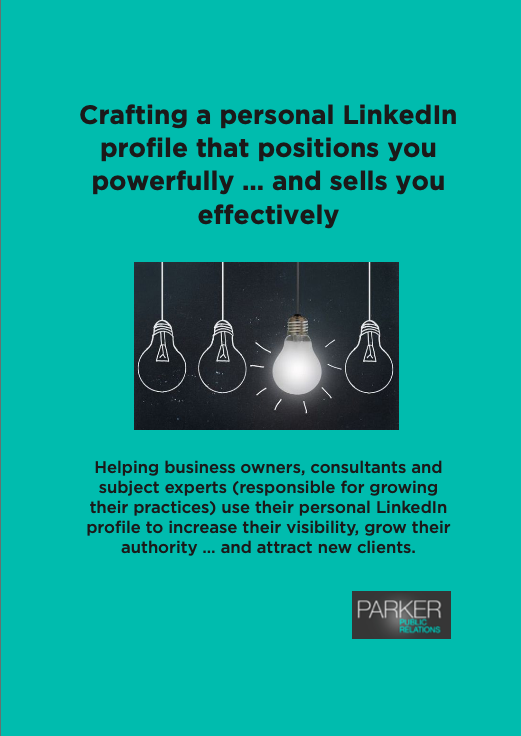You know that being the recognised authority or thought leader in your industry or field builds your credibility with your customer base and community, differentiates you from your competitors, commands respect from your industry peers … and helps you stand out in a crowded marketplace.
You also know that being a proven expert gets the attention of the media, opens up opportunities to headline a conference or be speaker and makes you more likely to be invited to join boards or commissions of inquiry.
You also know that being the reliable and trustworthy expert puts you in a powerful position to raise awareness on issues, challenge industry norms, put forward best practice solutions … and generally move things in a fresh or new direction.
But how to you begin building your personal brand and positioning yourself as a credible authority and thought leader? Where do you start and what’s involved?
These were some of the questions that were put to me up at a personal branding workshop which I delivered to RMIT Executive Master of Business Administration students recently. The students were business owners, professionals as well as executives in leadership and management roles.
And my response … develop a solid strategy and action plan and stick with it. Be consistent. You don’t have to be the cleverest person in the room, a fine orator or an amazing writer. You simply have to set out a course of action and stay the distance.
How to create a personal branding strategy
The following advice is relevant regardless of whether you’re looking to grow your expertise within your organisation, with your client-base, your industry or if you’re looking to take your ideas to a much wider external audience.
Step 1 – Define your purpose
Why are you looking to build your personal brand and grow your authority in the first instance? Is it about attracting new customers, showcasing best practice in your firm, raising awareness or advocating on a specific issue? Or is it about introducing a new way of doing things or about challenging and changing behaviours … even taking a stand on important social and political issues? If it’s about bringing in new business or growing your consultancy, do you simply want to speak to your clients or are you looking to take your thinking and expertise to a much larger global audience?
Step 2 – Get clear on your topic niche
What will you be talking and writing about moving forward? This is often dictated by your purpose or your intent for building your brand in the first instance. If it’s about attracting new customers and bringing in business, then your topic niche would typically be about your area of specialization or an area you are well credentialed to talk and write about. It could even be a sub-set of that specialization. For example, I am in public relations, personal branding and thought leadership, but I primarily write and speak about personal branding and thought leadership. However if your motive for building your branding is about raising awareness or taking a stand on an issue, that then becomes your priority topic.
Step 3 – Clarify your audience
Who do you need to educate, inform, influence or persuade? Who are the people who would benefit most what you have to talk or write about? Again this dependent on your purpose for wanting to build your authority and thought leadership. If you are responsible for bringing in business, it is absolutely about your customers and referral partners. If your personal branding is about raising awareness or advocating on a specific issue, your audience could be people within your organisation, your industry, your community, or your greater eco-system (suppliers, distributors, competitors, government agencies, and so on). Do keep in mind that if you are planning to secure publicity or become a speaker later on, do include relevant media and conference organisers as a key audience early on. It puts you on their radars and when you are ready to reach out, you are already a known quantity.
Step 4 – Define your communication channels and tactics
Where will you be telling your stories or providing your expertise, advice and opinions? What social sites will you use? What tactics (publicity, public speaking, social media engagement, authoring a business book or creating a personal website) and content formats (blog posts, articles, social media posts, videos, podcasts, infographics, images, webinars, e-books, newsletters, case studies, interviews, checklists) would you include. While your social media channels will be determined by where your audiences hang out and what they consume, your tactics and content format will be determined by your budget and how far you want to take your personal branding or thought leadership. If you are simply looking at growing your authority within your organisation, it could be something as simple as having a strong profile and presence on LinkedIn. However if you are looking at becoming an industry figure or household name it would be would be the full gamut of tactics and content formats.
TOP TIP: When choosing which tactics and content formats to settle on, pick those you are comfortable with or have experience in. Ideally pick off one at a time, before rolling out the next.
Step 5 – Develop the right kind of content
Regardless of whether you are using personal branding to grow your business, showcase best practise or raise awareness on issues … your content should primarily be about educating and informing your audience and providing them with content that is relevant and valuable to them. It should focus on solving their problems, answering their questions, alerting them to issues of relevance in the external environment, explaining difficult concepts, providing tips … bottom line about addressing issues that matter most to them. Promotional material should be kept to an absolute minimum. However do keep in mind that establishing what works best for your audience is often a matter of trial and error … so do be prepared to experiment.
Step 6 – Create your content calendar and action plan
A content calendar is a living document that maps out your personal branding and thought leadership activities. Its purpose is to keep you organized and accountable. It should cover off which tactics and platforms you will use. It should also include the stories and issues you will write about and the frequency of your activity. At the outset you may simply choose to comment on and share useful content on social media which you could do on a daily basis. Later on you may wish to post original content on a weekly or fortnightly and as your confidence grows intersperse written content with a video or podcast. Down the track you may even wish to investigate public speaking opportunities or to reach out to the media … even get cracking with your business book or create your own personal website. TOP TIP: When developing your content calendar, don’t attempt to create a calendar for the year … instead focus on the next 1-2 months. This enables you to be flexible and respond appropriately should your priorities change.
Need some help with building your personal branding strategy and action plan?
Parker Public Relations teaches CEOs, business leaders, C-suite, entrepreneurs, subject experts and academics how to build and manage their own thought leadership and personal branding. You roll up your sleeves and get involved! Our highly integrated offerings include a clever mix of strategy, content creation, publicity, social media engagement, business book coaching, podcasting and keynote speaking opportunities. We don’t take a cookie-cutter approach to what we do. Rather we partner with our clients, teaching them how to manage what they do best while we step in and take care of the rest.
Do get in touch:
0422 694 503
www.parkerpublicrelations.com.au
wendy@parkerpublicrelations.com.au


